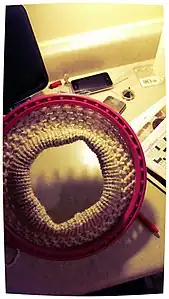
Spool knitting, loom knitting, corking, French knitting, or tomboy knitting is a form of knitting that uses a spool with a number of nails or pegs around the rim to produce a tube or sheet of fabric. The spool knitting devices are called knitting spools, knitting nancys, knitting frame, knitting loom, or French knitters.
The technique is to wrap the yarn around all of the spool's pegs, twice. The lower loop of yarn is then lifted over the upper loop and off the peg, thereby creating stitches. The yarn is then wrapped around the entire loom, creating a new upper yarn on each peg. This process is repeated until the project is complete.
Spool knitting frames typically have four or five pegs (or brass nails), although the number can range to more than 100.[1] Though not exclusively, the term "loom knitting" often refers to frames with more than those four or five pegs.
Uses

Many things can be made from the resulting tube. For example, it can be wound in a spiral to produce a mat or rug or, if a larger spool with more nails is used, a sock or a hat could be made. Historically, spool knitting has been used to make horse reins.[1]
Spool knitting is a traditional way to teach children the basic principles of knitting. According to Mary McCormack, author of Spool Knitting (published in 1909), "Few elementary exercises have aroused more interest in the child than the toy knitting; due, perhaps, to its simplicity and his power to do it easily and well."[2][3]
History

Knitting spools are the oldest members of the knitting loom family, with a history dating back over 400 years.[4] The earliest recorded reference to the use of a frame for knitting is in 1535 in Strasbourg in a legal decision about the proper guild for sock knitters.[5][6][7] It has been speculated by some 3D printing hobbyists that the so-called Roman dodecahedra might have been used as glove knitting devices, dating to c. 1st–5th century CE, however, this hypothesis has little support from the academic community and is not supported by the available historical evidence.[8] Lucets are essentially two-prong knitting frames.
Spools sold as "knitting nancys" sometimes had a figure painted or printed on them, thus resembling a wooden doll. Homemade knitting spools are sometimes made by placing a peg-like object, such as a nail, into a hard solid object, such as a block of wood (or a traditional wooden spool).
Beginning in the latter half of the 20th century, various small looms (usually plastic) using the same peg-knitting technique as knitting spools have been made. Some are larger than knitting spools, and can knit larger items. Some are straight, and make flat items such as blankets or scarfs, and some are round for making socks, hats, or other similar items. If the thread is not wrapped around in a helix, but back-and-forth, leaving two pegs with a space between that no yarn crosses, a flat sheet can be made on a round frame.[2]
 10th-century lucet spool from northern France.
10th-century lucet spool from northern France. Minimal spool knitting frame
Minimal spool knitting frame.jpg.webp) Traditional wooden spools of the sort used to hold thread, with a few nails driven into one end, make knitting spools.
Traditional wooden spools of the sort used to hold thread, with a few nails driven into one end, make knitting spools. A plastic 12-peg frame
A plastic 12-peg frame Spool knitting circle with 16 pegs
Spool knitting circle with 16 pegs Knitting a tuque (hat) on a larger frame
Knitting a tuque (hat) on a larger frame Oblong frame for circular knitting; note central slot between the two rows of pegs
Oblong frame for circular knitting; note central slot between the two rows of pegs It is not necessary to use the full length of an oblong frame
It is not necessary to use the full length of an oblong frame
Cranked versions
Simple versions contain just peg-like structures sticking up from a solid object. More complex ones operate complex mechanisms and automatically produce a knitted item with just a simple motion, such as a turn of a crank. See circular knitting#Spool and machine circular knitting for more on these machines.
.jpg.webp) Narrow hand-cranked spool knitting machine
Narrow hand-cranked spool knitting machine Larger hand-cranked circular knitting machine
Larger hand-cranked circular knitting machine 1800s knitting machine, also hand-cranked
1800s knitting machine, also hand-cranked A similar old sock-knitting machine in use
A similar old sock-knitting machine in use Close-up of a similar machine. Note how hooks rise and fall.
Close-up of a similar machine. Note how hooks rise and fall. 1959 power knitting machine
1959 power knitting machine.jpg.webp) Side view of 1959 machine
Side view of 1959 machine Machine for fine knitting
Machine for fine knitting A commercial machine knitting wool, 2000
A commercial machine knitting wool, 2000
See also
- I-cord is a similar, but not identical, knitting technique, done in knitting needles.[9]
References
- 1 2 "Spool Knitter". historicalfolktoys.com. Historical Folk Toys. Retrieved 7 December 2014.
- 1 2
- Mary A. McCormack (1909). Spool Knitting at Project Gutenberg, also at McCormack, Mary A. (Mary Anna) (1909). Spool knitting. New York : A. S. Barnes., also downloadable at File:Spool knitting (IA spoolknitting00mcco).pdf and File:Spool knitting (IA spoolknitting00mccorich).pdf
- ↑ Fisch, Arline M. (2003). Textile Techniques in Metal: For Jewelers, Textile Artists & Sculptors. Lark Books. pp. 64–. ISBN 978-1-57990-514-9.
- ↑ Phelps, Isela (2007). Loom Knitting Primer: A Beginner's Guide to Knitting on a Loom, with Over 30 Fun Projects. Macmillan. pp. 8–. ISBN 978-0-312-36661-2.
- ↑ von Schmoller, Gustav (1879). "67. Rathsentscheidung in einem Streite der Tuchersunft und der Zunft zum Spiegel. dass das Hosenstricker-Handwerk ze der erstern gehöre. 1535.". Die Strassburger tucher- und weberzunft: Urkunden und darstellung nebst regesten und glossar. Ein beitrag zur geschichte der deutschen weberei und des deutschen gewerberechts vom XIII.-XVII. jahrhundert. Strassburg: Verlag von Karl J. Trübner. Retrieved 27 January 2023.
- ↑ Rutt, Richard (1987). A History of Hand Knitting (U.S. ed.). Loveland, Colo.: Interweave Press. ISBN 0934026351. Retrieved 27 January 2023.
- ↑ Spencer, David J. (2001). Knitting technology : a comprehensive handbook and practical guide (3rd ed.). Lancaster, Pa.: Technomic. ISBN 9781855737556.
- ↑ Metcalfe, Tom (August 6, 2018). "The Mysterious Bronze Objects that Have Baffled Archaeologists for Centuries". Mental Floss. Retrieved 27 January 2023.
- ↑ Wolcott, Jill. "I-cord: the basics". Jill Wolcott Knits. Retrieved 8 January 2023.
External links
- Corking how to
- Spool Knitting Tutorials & Projects
- Spool knitting
- Mary A. McCormack (1909). Spool Knitting at Project Gutenberg, also downloadable at File:Spool knitting (IA spoolknitting00mcco).pdf and File:Spool knitting (IA spoolknitting00mccorich).pdf
